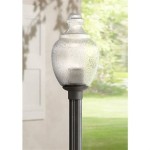How to Run Outdoor Electrical Conduit
Running electrical conduit outdoors is a common task for homeowners and electricians alike. Conduit provides a protective covering for electrical wires, shielding them from the elements and ensuring a safe and reliable electrical connection. This article outlines the essential steps for running outdoor electrical conduit, providing guidance on choosing the right materials, preparing the route, and installing the conduit properly.
Selecting the Appropriate Conduit
The first step is to choose the right type of conduit for your needs. The most common options for outdoor use include:
- PVC Conduit: Polyvinyl chloride (PVC) is a lightweight, durable, and corrosion-resistant material. It is commonly used for underground and above-ground applications.
- Metallic Conduit: Metal conduit, such as steel or aluminum, offers greater strength and fire resistance. It is typically used in areas where impact or damage is a concern.
- Flexible Conduit: Flexible conduit, often made of metal or plastic, is ideal for tight spaces and curves. However, it may not be as durable as rigid conduit.
The type of conduit you choose will depend on factors such as the location of the wiring, the size and type of conductors, and local building codes. Consult with a qualified electrician to ensure the correct type of conduit is selected for your project.
Preparing the Route for the Conduit
Once you've chosen the conduit, you need to prepare the route for installation. This involves marking the path of the conduit, ensuring it's clear of any obstacles, and digging trenches if necessary.
Here are some key steps:
- Mark the path: Use stakes and string to mark the path of the conduit, ensuring it's a straight line wherever possible.
- Clear the path: Remove any obstacles, such as trees, shrubs, or rocks, that may interfere with the installation of the conduit.
- Dig trenches: If the conduit needs to be buried underground, dig trenches that are wide and deep enough to accommodate the conduit and any necessary fittings. The depth of the trench will vary depending on local building codes and the type of soil.
Pay close attention to safety while digging trenches, ensuring you are aware of any underground utilities before starting to dig.
Installing the Conduit
With the route prepared, you can now install the conduit. Here are the steps involved:
- Cut the conduit: Use a pipe cutter or hacksaw to cut the conduit to the required lengths.
- Connect fittings: Use conduit fittings, such as elbows, tees, and couplings, to connect the conduit sections together. Make sure the fittings are compatible with the type of conduit you are using and are properly secured.
- Secure the conduit: Use conduit clamps, straps, or hangers to secure the conduit to walls, ceilings, or posts. Ensure the conduit is properly supported at intervals to prevent sagging.
- Install conduit boxes: Attach conduit boxes at the starting and ending points of the conduit run, as well as at any points where wires need to be connected.
- Pull wires through the conduit: Once the conduit is installed, you can pull the electrical wires through it. Use a fish tape or other wire-pulling tools to guide the wires through the conduit.
It is important to ensure that all electrical connections are made properly and that the conduit is installed according to local building codes and electrical safety standards. Consult with a qualified electrician if you are unsure about any aspect of the installation.
Additional Considerations
When running outdoor electrical conduit, consider the following factors:
- Weatherproof seals: Ensure all fittings and connections are weatherproof and adequately sealed to prevent moisture from entering the conduit.
- Grounding: Ensure the conduit is properly grounded to provide a safe path for electrical current in the event of a fault.
- Expansion and contraction: Consider the potential for expansion and contraction of the conduit due to temperature changes, especially in areas with extreme climates. Use appropriate fittings and installation methods to accommodate these movements.
- Accessibility: Ensure the conduit is accessible for inspection and maintenance.
Running outdoor electrical conduit is a specialized task that requires careful planning, proper materials, and a thorough understanding of electrical safety. By following the steps outlined in this article and consulting with a qualified electrician, you can ensure that your outdoor electrical system is safe, reliable, and compliant with relevant codes and standards.

How To Run Electrical Wiring Outside Family Handyman

Running Power To An Outbuilding Fine Homebuilding

Basic Outdoor Wiring Comes With Safety Precautions

Running Power To An Outbuilding Fine Homebuilding
:strip_icc()/SCW_164_02a-3d82113307cd4416b587ac98a60b964c.jpg?strip=all)
How To Install Pvc Conduit

Running Power To An Outbuilding Fine Homebuilding

How To Run Underground Power A Shed The Easy Way

How To Run Conduit Through Exterior Wall Aerosusa

Cantex Pvc Weatherproof Exposed Electrical Box Installation

Basic Outdoor Wiring Comes With Safety Precautions
Related Posts







